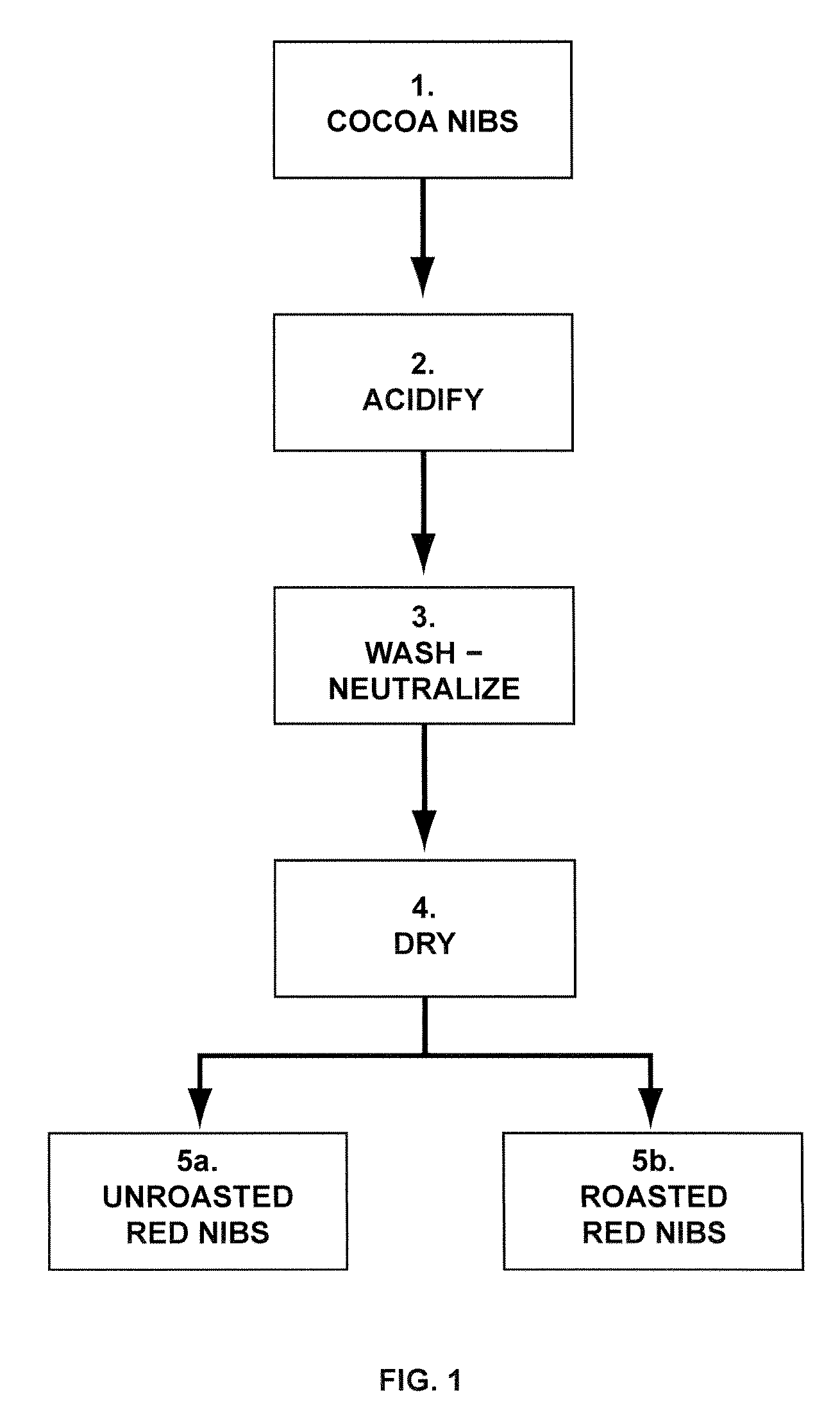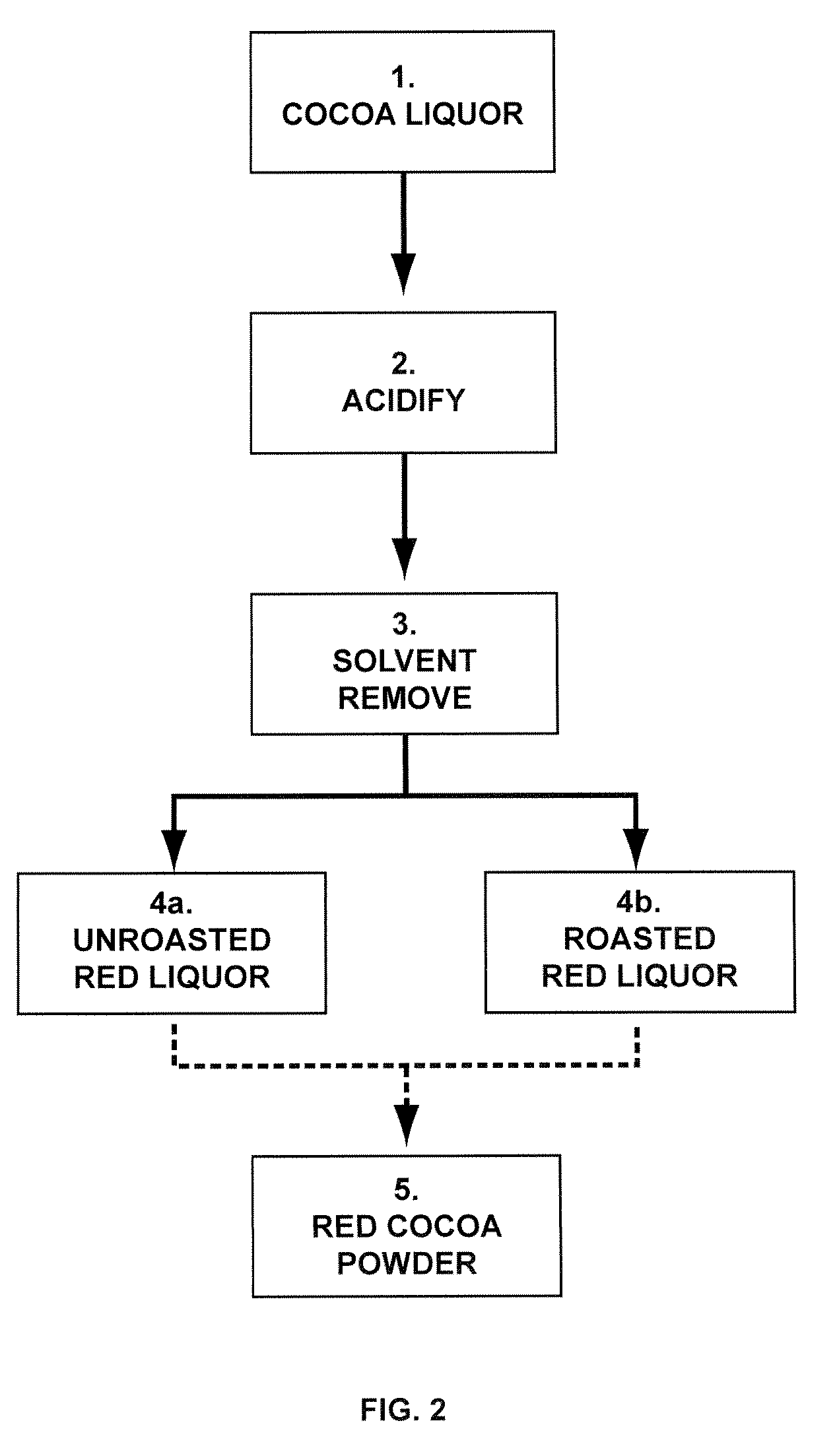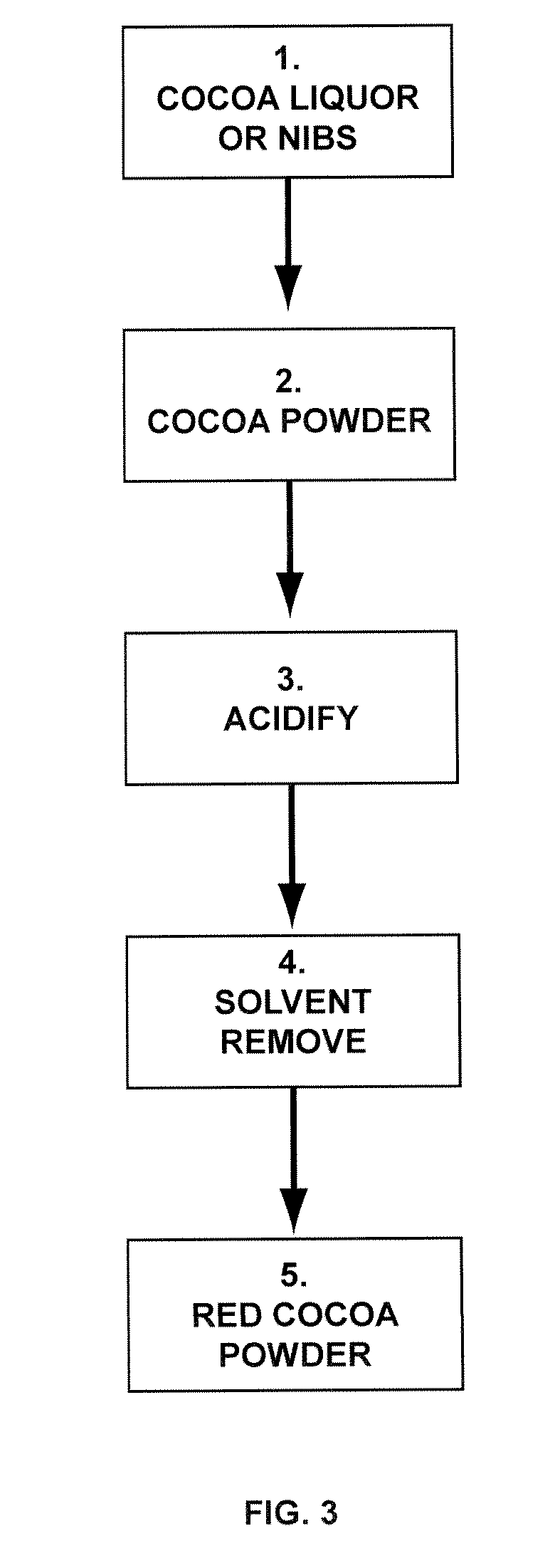[0004]In another aspect, the methods, food ingredients and products of this invention provide a new and novel way of making red cocoa products by acid treating unfermented or under-fermented
cocoa bean material in a
single step, and / or without extraction, to yield a very distinctive red / burgundy color and acceptable product
flavor while still maintaining high
antioxidant content. A further
advantage of the invention is the novel use of a neutralizing agent in the final product to reduce sourness and improve the
flavor profile of the products made from the invention.
[0005]As noted above, the invention, in one aspect, satisfies a need for beneficial cocoa ingredients containing high
antioxidant levels and capable of being used in a wide variety of food or consumable products at levels commonly associated with a cocoa liquor or
powder rather than an additive. For example, the acidified or red cocoa
powder, cocoa liquor, or cocoa solids produced from the methods of the invention can be used directly as the cocoa ingredient in a chocolate bar with or without other cocoa components. In these examples, the cocoa products and ingredients have the added
advantage of having a red color or
hue compared to untreated natural cocoa products. A further
advantage is the distinctive taste profile that results from the cocoa products made from the methods of the invention. And yet a further advantage is the lack of an alkalizing step to produce the red color, as alkalizing is known to reduce the levels of epicatechin and other beneficial cocoa compounds (Miller, K. B., J. Ag. Fd. Chem. 2008, 56:8527). In combination with other known
antioxidant compounds found in foods or cocoa, the new cocoa products, chocolates, and food ingredients and products advantageously provided by the invention create new possibilities for producing or supplementing foods with beneficial levels of natural cocoa compounds, such as flavanols, flavanoids, resveratrols, polyphenols, and other antioxidants. Furthermore, the advantageous use and effect of the acidification process, using
food grade acids (e.g. citric, ascorbic, phosphoric, acetic, fumaric) and / or low pH food-derived compositions (e.g.,
lemon juice concentrate) and / or other low pH compositions (e.g., glucono-
delta-
lactone,
sodium acid
sulfate) on the color and / or flavor of the cocoa product would not have been expected given the
prevalence of alkalization steps in cocoa
processing.
[0006]The invention relates to methods of treating and / or
processing raw or fresh cacao seeds, commonly referred to as beans, and parts thereof to make cocoa ingredients or products having improved properties or characteristics. In particular, the invention relates to methods of producing cocoa ingredients or products while preserving or maintaining high levels of natural antioxidants, and / or where a red color or
hue results. Color measuring methods are known in the art, and Hunter color
score a / b ratios of about 2.0 or higher are preferred, and ranges from about 2 to about 6, and 3 to about 5 or 6 are more preferred. Alternatively or in addition, the Hunter or the Macbeth color “a” values for red cocoa ingredients of the invention, like cocoa powder and cocoa liquor, can be in the range of about 16 to about 25, and / or the color “b” values for the red cocoa ingredients can be in the range of about 4 to about 7. Therefore, on at least a theoretical basis, red cocoa powder and cocoa liquor of the invention can have a Hunter or Macbeth
score a / b ratio as high as 12, and typically is above 2. Accordingly, the red hue of the cocoa products of the invention can be defined using any one or more of the “a” or “b” or “a / b” values or ranges discussed here or reported in the examples below or elsewhere in this disclosure. In one embodiment the invention comprises the use of an acid solution to produce red cocoa ingredients from unfermented or under-fermented cocoa beans or nibs. Substantially unfermented cocoa beans or nibs are treated with an acid composition followed by washing and / or
solvent removal from the treated nibs and
processing the nibs into a cocoa ingredient for use in a food ingredient or product. The cocoa ingredient formed has a red color or hue and is capable of being used at 0.1-1% by weight, but preferably 1% or more by weight, in a food product so that the food product exhibits a distinctive red color, acceptable flavor and / or a desired amount of antioxidant or beneficial cocoa compounds.
[0008]In general, the methods of the invention can be used to produce a cocoa ingredient, which may be a chocolate liquor, a cocoa powder, or other cocoa-derived product known, used, or available. One of skill in the art is familiar with many uses of such cocoa ingredients, and no particular use is required here. However, typical uses for such products as cocoa
mass or chocolate liquor and / or cocoa powder are in the production of a chocolate product, including but not limited to, a
milk chocolate product, a
dark chocolate product, a semisweet or bittersweet chocolate product, a chocolate-flavored product, a
chocolate confectionery, a chocolate-flavored confectionery, a beverage, a chocolate beverage, a chocolate-flavored beverage, a dairy based product, a yogurt, a
dietary supplement, a chocolate-coated product, chocolate coatings and icings, a low fat chocolate product, or a low-
sugar chocolate product, or a no
sugar added cocoa product. Advantageously, the cocoa and chocolate products can be made to have a red color or hue, which can be associated with distinctive or premium cocoa products. Additionally, the incorporation of red cocoa ingredients in any liquid or
solid product that has an acidic base, such as a yogurt, enhances or imparts a characteristic red color to the food and has the added benefit of preserving high levels of cocoa epicatechin in the final food product.
[0009]In the methods of producing a red cocoa ingredient for use in preparing a food product or ingredient, the removal of,
evaporation of, washing to remove, and / or vacuum treatment or
drying of the cocoa composition
after treatment with an acid composition can be performed in one or a multiple of ways. In general, this removal or washing step substantially reduces the acid after-taste of the final product or ingredient. However, it is acceptable to have a slight acid after-taste, which can promote a sour fruit or yogurt-like flavor in the final food product. Accordingly, the removal,
drying, or washing to reduce the acid need not be a complete removal or result in
elimination of all the titratable acidity present at any stage in the process. Further, additives can be used in a final food product to cover or
mask some of the acidity or acid taste remaining, and many food-acceptable bases or buffering systems can be used, such as but not limited to
calcium carbonate,
potassium carbonate and
sodium hydroxide. Preferably, the bases or buffering systems are added to a final product, near the final processing into a product, and / or at the point in processing where a low
moisture level and / or a low
water activity level is maintained, such as in a chocolate or chocolate liquor.
 Login to View More
Login to View More  Login to View More
Login to View More 


